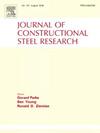Inelastic reserve strength of CFS sections subjected to unsymmetrical centroidal axis bending
IF 4
2区 工程技术
Q1 CONSTRUCTION & BUILDING TECHNOLOGY
引用次数: 0
Abstract
The inelastic reserve strength of cold formed steel (CFS) sections in AISI-S100 & AS/NZ 460 standards are expressed in direct strength method (DSM) for local and distortional buckling modes, which are derived from the studies on lipped channel and lipped Zee sections subjected to bending about the symmetric(major) centroidal axis. This study aims to check the adequacy of existing provisions to LC and Hat sections subjected to bending about un-symmetric(minor) centroidal axis such that the lipped edge is under compression. The Non-linear finite element analysis was carried out with the variation of width/thickness ratios of flange and lip depths between zero and adequate depth for three different grades of steels. Further, the strength was estimated analytically by imposing the complete stress-strain profile including strain hardening component across the section. Though the above sections exhibit distortional mode from the analysis, the inelastic reserve strength estimations from existing DSM distortional equations were shown to be conservative compared to numerical and analytical results. To address the conservative strength estimations, the present work proposes modifications in two stages 1) A new equation for limiting strain ratio ‘C' as a function of non-dimensioned slenderness ratio ‘λ’ and applied strain/stress gradient ‘ψ’. 2) An additional strain hardening component derived to be used with existing DSM provisions. Further, the strength was also estimated through continuous strength method (CSM) by deriving a generalized shape factor ‘ag’ in the form of design tables and charts. The proposed DSM and CSM strength equations exhibit a good correlation with the past experimental data and yields more reliable strength predictions.
非对称质心轴弯曲作用下CFS截面的非弹性储备强度
在 AISI-S100 & AS/NZ 460 标准中,冷成型钢 (CFS) 截面的非弹性储备强度是以局部和扭曲屈曲模式的直接强度法 (DSM) 表示的。本研究的目的是检查现有规定是否适用于围绕非对称(次要)中心轴弯曲的 LC 和 Hat 断面,即有衬里边缘受压。在对三种不同等级的钢材进行非线性有限元分析时,凸缘的宽度/厚度比和唇缘深度在零和足够深度之间变化。此外,通过对整个截面施加包括应变硬化成分在内的完整应力-应变曲线,对强度进行了分析估算。尽管上述截面在分析中表现出扭曲模式,但与数值和分析结果相比,现有 DSM 扭曲方程的非弹性储备强度估计值显示出保守性。为解决强度估算保守的问题,本研究分两个阶段提出了修改建议 1) 将极限应变比 "C "作为无尺寸细长比 "λ "和外加应变/应力梯度 "ψ "的函数,建立新的方程。2) 结合现有的 DSM 规定,得出了额外的应变硬化成分。此外,还通过连续强度法(CSM),以设计表格和图表的形式推导出通用形状系数 "ag",从而估算出强度。所提出的 DSM 和 CSM 强度方程与过去的实验数据具有良好的相关性,并能得出更可靠的强度预测结果。
本文章由计算机程序翻译,如有差异,请以英文原文为准。
求助全文
约1分钟内获得全文
求助全文
来源期刊

Journal of Constructional Steel Research
工程技术-工程:土木
CiteScore
7.90
自引率
19.50%
发文量
550
审稿时长
46 days
期刊介绍:
The Journal of Constructional Steel Research provides an international forum for the presentation and discussion of the latest developments in structural steel research and their applications. It is aimed not only at researchers but also at those likely to be most affected by research results, i.e. designers and fabricators. Original papers of a high standard dealing with all aspects of steel research including theoretical and experimental research on elements, assemblages, connection and material properties are considered for publication.
 求助内容:
求助内容: 应助结果提醒方式:
应助结果提醒方式:


